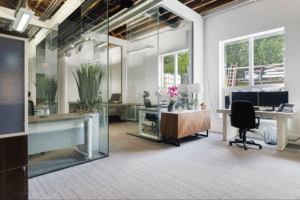Innovative materials for noise reduction in commercial spaces
by arslan_ahmed | July 31, 2023 11:00 am
 [1]
[1]By Ryan Shure
Many types of buildings are considered commercial spaces. Commercial spaces are often large, bustling structures, required to withstand a high volume of human and machine traffic, more than a residential property. Managing sound transfer into and throughout a large commercial building can present a serious challenge. To help manage this issue, this article ranks seven innovative materials, from most to least comprehensive, which can reduce noise in commercial spaces.
Insulated concrete forms (ICFs)
Many times, the bustle inside the building is minor, compared to the commotion created by blaring traffic, strong winds, and pounding precipitation. If any of these factors are a concern, it is important to build with sound attenuation in mind.
This starts with the framing; structural steel is an outstanding material for framing commercial buildings thanks to its durability, but it is not the ideal option for soundproofing. A better choice would be ICF. Composed of interlocking insulation panels set by concrete on-site, ICF framing creates a solid, one-piece frame which does an exceptional job of preventing sound from transferring through the building envelope. Many exterior sounds are initially reflected by the concrete. Any waves that do pass through this initial defence are absorbed by the foam insulation core, ensuring few, if any, sound waves make their way to the building’s interior.
By providing sound-insulative framing, ICF represents the most impactful means of reducing noise in a commercial building, with structures using this material performing better than other buildings that use only surface-level noise mitigation techniques.
Office acoustic panels
Once the foundation and framing are in place, the only way to truly soundproof a space is by adding an insulative mass in which sound waves are absorbed, cancelled/blocked, and unable to travel further. However, most practices for adding insulative mass are considered unattractive.
For example, decoupling walls is a strong option for adding soundproofing mass. This involves separating walls into two sections, and the sound waves are lost in the chasm between them. In most applications, this involves adding an extra layer of drywall or some other type of “false front.” Not only does this cut into interior square footage, but it is not practical for open interiors with many windows. In addition, many types of sound-absorbing foam are bulky, unsightly, and inconvenient, leaving building managers with few interior design options.
To help add soundproofing mass without undermining style, decorative acoustic panels are gaining popularity in use for modern commercial buildings.1 Fabricated from a fibreglass core sheathed in decorative fabric, office acoustic panels feature a noise reduction coefficient (NRC) of 0.95, just short of the industry standard (one) for complete soundproofing. While this is an impressive figure, it is important to note that performance may vary based on the room’s shape and wall surface area. For example, lower frequency sounds tend to reverberate in the corners of rooms, so acoustic panels may not be as effective at absorbing these sounds in rooms with many sharp angles (consider bass traps for this purpose). In addition, it is recommended for acoustic panels to be mounted on 15 to 25 per cent of the wall area. Anything short of this will reduce the panels’ NRC.
However, adding sufficient acoustic panels should not detract from the area’s esthetics. In most scenarios, office acoustic panels adhere to the wall and are as subtle as a picture frame, with their decorative quality giving the impression of interior decor and not sound mitigation.
 [2]
[2]Acoustic ceiling clouds
Modern commercial buildings are notably more open than their cubicle-centric predecessors. This can lead to some challenges regarding echo and unwanted noise transfer in sprawling interiors.
For years, buildings used a drop ceiling design to help reduce noise transfer in commercial interiors. Similar in concept to decoupling walls, a suspended drop ceiling hides the underlying structural ceiling, with sound waves being absorbed in the plenum space between the two.
While this approach works reasonably well for reducing noise transfer between building stories, it is not as effective at managing sound transfer on the same storey. To increase acoustic properties and add elements to a drop ceiling, modern acoustic ceiling clouds fit the bill.
Typically fabricated in the form of fabric-wrapped fibreglass (similar to wall acoustic panels), foam, perforated metal, or polyester, strategically-placed ceiling clouds can absorb up to 95 per cent of all the noise in a room, keeping conversations local in a sprawling interior while adding an element of architectural intrigue.
Glass partition walls
Despite the energy efficiency and customization upside of keeping commercial interiors open, there will be times when privacy is necessary. Acoustic panels and ceiling clouds can go a long way in preventing noise transfer, but they do not eliminate the chance of a random passerby overhearing parts of a private conversation or conference call.
For this purpose, custom glass partition walls are a great choice. They can be applied behind lobby counters, between office desks, or installed as complete floor-to-ceiling walls to create private meeting areas as necessary. These types of stylish glass partitions block and absorb sound while maintaining the bright, inviting ambiance of open commercial interiors. Thicker glass provides a higher sound transmission rating. Two layers of glass are often specified for rooms that require a sound transmission class (STC) rating higher than 36.
Flooring materials
When designing a commercial building, there are a few different kinds of noise to account for, and one of them is ambient airborne noise, which is noise transferred through the air (e.g. dogs barking, traffic blaring outside, professionals conversing, etc.). Ambient airborne noise is mitigated by adding mass and choosing sound-absorbing materials.
Impact-generated noise is created when the building’s mass receives some sort of impactful blow (e.g. footsteps, machine traffic, projectile debris, etc.), causing sound waves to “vibrate” and travel through the material. Impact-generated noise is largely an architectural concern and needs to be addressed during the design and construction processes. To this effect, the floor is a major architectural element that can either facilitate or diminish impact-generated noise, depending on the materials and design used.
Acoustic flooring can be a bit of a challenge in commercial spaces. The most durable flooring materials well-suited to withstand heavy use and abuse, such as polished concrete and epoxy terrazzo, are generally considered “loud” flooring materials and are susceptible to impact-generated noise and reflected sound waves. To enhance the sound insulation of these types of floors, there are some products, such as acoustic membranes, which are bonded to the surface before the finish is applied, to help absorb impact and limit sound wave transfer.
In multi-storey buildings, acoustic underlayment is added beneath hard floors to absorb noise transfer from lower levels. If the flooring is already in place and neither of these solutions are practical, strategically placing area rugs and rubber mats can add some noise-absorbing mass to the flooring surface.
Acoustic furniture
Cushioned, upholstered furniture does a better job of absorbing sound than more sound-reflective metals and plastics. However, traditional cushioned furniture does not always perform well outside of lobbies or waiting rooms, with more rigid desks and chairs preferred by many professionals for maintaining proper work posture.
Some companies have taken this into consideration to blend both these functions and produce sound-absorbing furniture fit for the office. With cutting-edge engineering that makes use of fabrics, angles, and built-in barriers, this type of innovative furniture works wonders for enhancing localized productivity in larger commercial spaces.
Acoustic paint
Although it is not the most impactful means of soundproofing a commercial building, acoustic paint is another way to help achieve some level of sound mitigation. As its name applies, paint is rolled or sprayed onto interior surfaces to help deaden some of the sound in noisy facilities.
Acoustical paint is noticeably thicker than standard wall paint. This additional soundproofing mass is achieved through the presence of fillers made of ThermaCels and ceramic microspheres. ThermaCels are vacuum-sealed packages with soft pigments inside. When sound hits these packages, the sound waves vibrate and lose intensity as they travel through the pigments. The ceramic microspheres add density between the ThermaCels, eliminating gaps through which sound waves can typically travel in regular wall paint. It is recommended to apply multiple layers or coats of acoustical paint to effectively maximize its sound mitigating potential.
With that said, due to its relatively minor mass, acoustic paint is not as effective at soundproofing as the other materials listed. However, it does have the benefit of being fast and affordable. It can also have some utility in older structures which have many cracks and crevices in the walls and window framing. Spray-on acoustic paint can effectively penetrate these areas and provide some sound defence.
Improving customizability
Managing noise in a commercial space is critical for ensuring the productivity of employees and the satisfaction of guests. While any of the seven innovative materials mentioned can help manage sound in a commercial structure, framing with ICF will be the most impactful in reducing sound, as it reflects and absorbs sound waves at the foundational level. However, if the building is already intact, office acoustic panels and ceiling clouds are highly effective at absorbing sound waves.
Notes
1 Learn more about decorative acoustic panels, acousticalsolutions.com/decorative-acoustic-panels[3].
 [4]Author
[4]Author
Ryan Shure is a freelance writer who loves sharing his knowledge and expertise on renovations and construction. He lives in Tampa, Florida, where he enjoys spending time researching building material trends in his free time. Shure’s work as a freelance writer can be found on Building Product Advisor.
- [Image]: https://www.constructioncanada.net/wp-content/uploads/2023/07/image4.gif
- [Image]: https://www.constructioncanada.net/wp-content/uploads/2023/07/image1.gif
- acousticalsolutions.com/decorative-acoustic-panels: https://acousticalsolutions.com/decorative-acoustic-panels/
- [Image]: https://www.constructioncanada.net/wp-content/uploads/2023/07/Shure_Headshot-f.jpg
Source URL: https://www.constructioncanada.net/innovative-materials-for-noise-reduction-in-commercial-spaces/